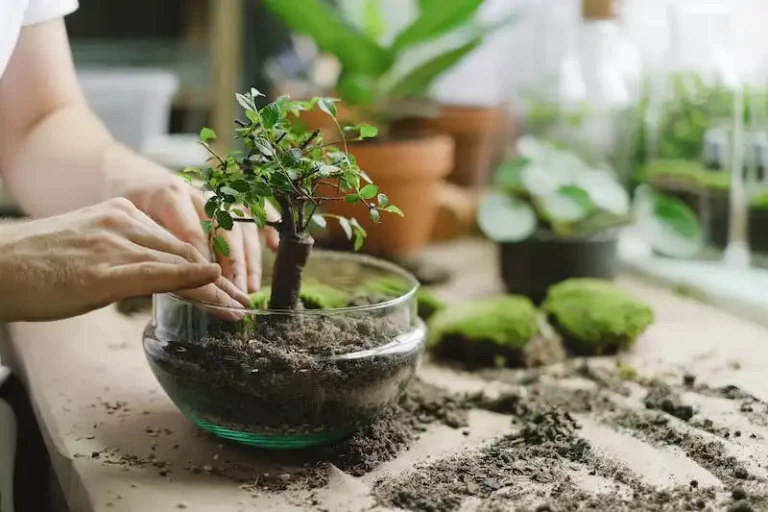If you’re looking to create a miniature alpine garden, but don’t have the space or conditions needed to replicate the alpines in your own garden, a trough could be the perfect container for you. Troughs are able to provide the best growing conditions for alpine plants, as they can recreate the well-drained and low-nutrient environments that alpines thrive in.
Choosing the right container is the first step in creating an alpine garden in a trough. You’re looking for a container that is able to withstand the winter weather conditions, as well as being able to hold enough soil to support the chosen alpine plants. John Skelly, a master of alpine horticulture, recommends using a trough that is at least 40cm (15in) long, 20cm (8in) wide, and 10cm (4in) deep.
After choosing the right trough, it’s time to start planting. Five alpine plants are usually sufficient to create a beautiful garden in a trough. Pulsatilla vulgaris, also known as the Pasque flower, is a great choice for its vigorous growth and stunning purple flowers. Other options include evergreen foliage plants, such as Sedum, that provide interest all year round. When planting, it’s important to use inorganic material, such as rocks or pebbles, to ensure proper drainage.
Caring for your alpine garden in a trough is relatively easy. Alpines are adapted to harsh conditions, so they are naturally suited to surviving with little rainfall. However, they do need regular water during the growing season, especially in late spring and summer. Aftercare is important as well, especially in winter. During heavy rainfall, it’s advisable to move the trough to a spot where it’s protected from excessive wetness.
To finish off, here’s a quote from John Skelly’s guide on creating an alpine trough: “Alpine troughs give you the opportunity to create your own little piece of the alpine world, right in your own garden. It may not be the same as being in the mountains, but it’s as close to it as you can get.” So why not give it a try and create your own alpine garden in a trough this year?
How to Plant an Alpine Trough
If you’re a gardening enthusiast looking to create your own alpine garden, planting an alpine trough is a great way to start. Alpine plants thrive in mountainous conditions, so by replicating these conditions in your own trough, you can enjoy a miniature mountain garden right in your backyard.
To start, you’ll need a trough or a deep container that is at least 8 inches deep to give your plants enough room to grow. The trough should be filled with a well-draining soil mix. You can create your own soil mix by combining equal parts gravel, sand, and a general-purpose potting mix. This will mimic the rocky and well-drained soil conditions found in mountain regions.
When selecting plants for your alpine trough, choose varieties that are suited to your specific climate and growing conditions. Alpine plants are typically low-growing, with attractive foliage and vibrant flowers. Some popular choices include pulsatilla, masterwort, and skelly. Make sure to choose plants that are vigorous enough to thrive in the tough conditions of an alpine trough.
Line the bottom of your trough with rocks to create a natural-looking rock garden. This will also help with drainage and provide a beautiful backdrop for your plants. Plant your selections within the trough, spacing them out to give each plant enough room to grow. You can also create different levels within the trough by layering rocks and soil to add depth and interest to your display.
After planting, make sure to give your plants regular care and aftercare. Alpine plants prefer sunny spots, so place your trough in a location that receives at least 8 hours of direct sunlight. Water your plants enough to keep the soil moist, but make sure not to overwater as alpine plants are not fond of drenched conditions.
Alpine plants are generally hardy and can withstand harsh weather conditions, but it’s always a good idea to protect them during extreme weather. If you’re expecting frost or heavy rainfall, you can cover your trough with a protective cloth or move it to a more sheltered spot. Some alpine plants are evergreen, meaning they retain their foliage throughout the year, while others go dormant during the winter months.
In general, alpine plants don’t require much feeding. However, you can give them a light fertilizer application in early spring to help promote healthy growth and flowering. It’s also important to remove any weeds that may pop up, as they can compete with your alpine plants for nutrients and water.
By following this guide, you’ll be well on your way to creating your own alpine garden in a trough. Enjoy the beauty of mountainous landscapes and the joy of caring for these unique and resilient plants in your own backyard!
What You’ll Need to Plant an Alpine Trough
When it comes to creating an alpine garden in a trough, there are a few things you’ll need to gather before you begin. As alpine plants have adapted to grow in rocky, mountainous environments, it’s essential to replicate these conditions in your trough. Here’s a list of what you’ll need:
1. Trough or Container: Choose a container that is deep enough to accommodate the roots of your alpine plants. A trough-like container is ideal as it allows room for the roots to spread.
2. Rocks or Gravel: Use rocks or gravel to create good drainage within the trough. This will prevent water from pooling around the roots and ensure the plants thrive.
3. Well-Drained Soil: Alpine plants prefer well-drained soil, so it’s important to choose a special mix that suits their needs. Look for soil that is sandy or gritty, as this will replicate the natural conditions they prefer.
4. Alpine Plants: When choosing plants for your alpine trough, opt for those that are known to withstand harsh alpine conditions. Look for plants with small, tough leaves and vibrant flowers to add color to your display.
5. Sunny Spot: Most alpine plants need plenty of sun to grow well. Choose a location that receives at least six hours of direct sunlight daily.
6. Aftercare: Alpine plants are generally low-maintenance, but they still require some aftercare. Regular watering during dry periods and removing any weeds or dead foliage will help keep your alpine trough looking its best.
In addition to these basic necessities, there are a few extra tools and materials you may find useful:
– Gardening Gloves: Protect your hands when handling rocks, plants, or soil.
– Hand Trowel: Use a hand trowel to dig holes and plant your alpine plants.
– Watering Can: A watering can with a narrow spout is handy for delivering water directly to the roots of your plants.
– Plant Labels: Label your plants to keep track of their names and care requirements.
No matter how much experience you have as a gardener, planting an alpine trough is a rewarding project that can bring unique beauty to your garden. With the right materials and care, your alpine garden in a trough will thrive, creating a beautiful display of vibrant colors and intriguing foliage.
Caring for Alpine Plants
Alpine plants are a great option for any gardener looking to create a stunning display in their outdoor space. These hardy plants are well-suited to high mountainous conditions and can thrive in a range of soils. If you want to grow alpines in your garden, here’s a guide on how to care for them:
| Choosing the right plants | Creating the right conditions | Aftercare |
|---|---|---|
| Select plants that are suitable for your climate and chosen location. Alpine plants prefer sunny, well-drained soils, so choose a spot in your garden that gets plenty of sunlight and has good drainage. | Alpine plants are used to harsh mountain weather conditions, so creating similar conditions in your garden is key to their success. A corner of the garden that is sheltered from heavy rainfall and strong winds is ideal. You can also create a raised bed or use a trough or container filled with a mix of gravel and well-drained soil. | After planting, make sure to water your alpines regularly, especially during dry spells. However, be careful not to over-water, as the roots can rot in heavy, waterlogged soils. A general rule of thumb is to water when the top inch of soil feels dry to the touch. You may also need to provide some protection during the winter months, covering the plant with plastic or mulch to shield it from harsh frost. |
Alpine plants have a stunning variety of foliage and flower colors, so choose the ones that appeal to you most. Some popular options include rock cress, stonecrop, and skelly. These plants will grow vigorously and stand out in any garden. Whichever plants you choose, follow this care guide and you’ll be on your way to becoming a master of alpine gardening!
Source: Monday’s Horticulture Guide, January 2024
Plants for an Alpine Trough
If you’re looking to create an alpine garden in a trough, selecting the right plants is key. Alpine plants are often small, hardy plants that grow in mountainous regions and are well-suited for rock gardening. They thrive in conditions with well-drained soil and are usually able to withstand harsh weather conditions.
When choosing plants for your alpine trough, it’s important to consider the size of the trough and the conditions it will be placed in. Most alpines prefer a sunny location, so make sure your trough will receive enough sunlight throughout the day. The trough should also have good drainage to avoid waterlogged soil, especially during wetter seasons.
Alpine plants come in a variety of shapes, sizes, and colors, so you’ll have plenty of options to choose from. Some common alpines for trough gardening include early-flowering types like yellow saxifrage and daisy-like alpines such as hens-and-chicks.
When planting your trough, it’s best to start in early spring, preferably in March. You can either use a mixture of alpine compost and grit or a specific alpine potting mix. Fill the trough to a point where it will comfortably accommodate your plants.
When planting your alpines, consider their growth habit and how they will form a display. Start off by planting the larger, taller plants towards the back of the trough, using plastic pots with the bottoms cut out to contain the roots. Place smaller rock-garden plants in the gaps between the larger ones to create a more natural look.
It’s important to water your trough regularly, especially during dry periods. Although alpine plants are generally hardy, they do require some care and attention. If rainfall is not sufficient, make sure to water your trough to keep the plants happy and healthy.
As a gardener, replicating mountainous conditions with your alpine trough can be a great challenge, but also very rewarding. The plants you select will depend on the specific conditions of your trough and the look you’re going for. References to alpine society guides and horticultural references will help guide you in choosing the right plants for your trough.
In conclusion, when it comes to alpine trough gardening, selecting the right plants is crucial. Consider the size and conditions of your trough, and choose a selection of alpines that will thrive in those circumstances. With proper care and attention, your alpine trough will create a beautiful display, replicating the natural beauty of the mountains above.

